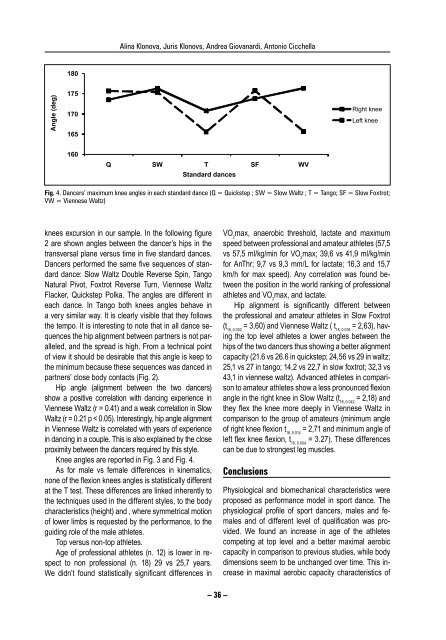Antropomotoryka nr 55.indb - Akademia Wychowania Fizycznego w ...
Antropomotoryka nr 55.indb - Akademia Wychowania Fizycznego w ...
Antropomotoryka nr 55.indb - Akademia Wychowania Fizycznego w ...
Create successful ePaper yourself
Turn your PDF publications into a flip-book with our unique Google optimized e-Paper software.
Alina Klonova, Juris Klonovs, Andrea Giovanardi, Antonio Cicchella<br />
<br />
<br />
<br />
<br />
<br />
<br />
<br />
<br />
<br />
<br />
Fig. 4. Dancers’ maximum knee angles in each standard dance (Q = Quickstep ; SW = Slow Waltz ; T = Tango; SF = Slow Foxtrot;<br />
VW = Viennese Waltz)<br />
knees excursion in our sample. In the following figure<br />
2 are shown angles between the dancer’s hips in the<br />
transversal plane versus time in five standard dances.<br />
Dancers performed the same five sequences of standard<br />
dance: Slow Waltz Double Reverse Spin, Tango<br />
Natural Pivot, Foxtrot Reverse Turn, Viennese Waltz<br />
Flacker, Quickstep Polka. The angles are different in<br />
each dance. In Tango both knees angles behave in<br />
a very similar way. It is clearly visible that they follows<br />
the tempo. It is interesting to note that in all dance sequences<br />
the hip alignment between partners is not paralleled,<br />
and the spread is high. From a technical point<br />
of view it should be desirable that this angle is keep to<br />
the minimum because these sequences was danced in<br />
partners’ close body contacts (Fig. 2).<br />
Hip angle (alignment between the two dancers)<br />
show a positive correlation with dancing experience in<br />
Viennese Waltz (r = 0.41) and a weak correlation in Slow<br />
Waltz (r = 0.21 p < 0.05). Interestingly, hip angle alignment<br />
in Viennese Waltz is correlated with years of experience<br />
in dancing in a couple. This is also explained by the close<br />
proximity between the dancers required by this style.<br />
Knee angles are reported in Fig. 3 and Fig. 4.<br />
As for male vs female differences in kinematics,<br />
none of the flexion knees angles is statistically different<br />
at the T test. These differences are linked inherently to<br />
the techniques used in the different styles, to the body<br />
characteristics (height) and , where symmetrical motion<br />
of lower limbs is requested by the performance, to the<br />
guiding role of the male athletes.<br />
Top versus non-top athletes.<br />
Age of professional athletes (n. 12) is lower in respect<br />
to non professional (n. 18) 29 vs 25,7 years.<br />
We didn’t found statistically significant differences in<br />
VO 2<br />
max, anaerobic threshold, lactate and maximum<br />
speed between professional and amateur athletes (57,5<br />
vs 57,5 ml/kg/min for VO 2<br />
max; 39,6 vs 41,9 ml/kg/min<br />
for AnThr; 9,7 vs 9,3 mm/L for lactate; 16,3 and 15,7<br />
km/h for max speed). Any correlation was found between<br />
the position in the world ranking of professional<br />
athletes and VO 2<br />
max, and lactate.<br />
Hip alignment is significantly different between<br />
the professional and amateur athletes in Slow Foxtrot<br />
(t 18, 0.002<br />
= 3,60) and Viennese Waltz ( t 18, 0.016<br />
= 2,63), having<br />
the top level athletes a lower angles between the<br />
hips of the two dancers thus showing a better alignment<br />
capacity (21.6 vs 26.6 in quickstep; 24,56 vs 29 in waltz;<br />
25,1 vs 27 in tango; 14,2 vs 22,7 in slow foxtrot; 32,3 vs<br />
43,1 in viennese waltz). Advanced athletes in comparison<br />
to amateur athletes show a less pronounced flexion<br />
angle in the right knee in Slow Waltz (t 18, 0.042<br />
= 2,18) and<br />
they flex the knee more deeply in Viennese Waltz in<br />
comparison to the group of amateurs (minimum angle<br />
of right knee flexion t 18, 0.014<br />
= 2,71 and minimum angle of<br />
left flex knee flexion, t 18, 0.004<br />
= 3.27). These differences<br />
can be due to strongest leg muscles.<br />
Conclusions<br />
Physiological and biomechanical characteristics were<br />
proposed as performance model in sport dance. The<br />
physiological profile of sport dancers, males and females<br />
and of different level of qualification was provided.<br />
We found an increase in age of the athletes<br />
competing at top level and a better maximal aerobic<br />
capacity in comparison to previous studies, while body<br />
dimensions seem to be unchanged over time. This increase<br />
in maximal aerobic capacity characteristics of<br />
– 36 –





![Antropomotoryka nr 57 [2012]. - Akademia Wychowania Fizycznego ...](https://img.yumpu.com/50213388/1/182x260/antropomotoryka-nr-57-2012-akademia-wychowania-fizycznego-.jpg?quality=85)











